Preparing for your data migration project
Preparing for a payroll data migration is a huge task. It is a very complex process involving multiple people and enormous amounts of time and effort. However, this process can be made simpler and much safer. We came up with a few steps for you to follow so that migrating payroll data becomes easy for you. Messing up in the process of migration can result in loss of data, severely hampering your day-to-day operations.
We have created a list of six steps you could follow.
Appoint personnel and assign responsibilities
Choosing the right person for payroll data migration task is extremely important. The person should know both the legacy system and the new system and should be aware of how the new payroll software is supposed to work. In case there is no one amongst your employees who has the necessary skills then, consider hiring a third party for migrating payroll data. A slight increase in cost is worth it to avoid losing valuable data.
Select the right data points and have backups
After appointing the correct personnel for the job, the next task is to identify the documents and data that are needed to be ported over. Make sure that the data is backed up and a copy is made so that any mistakes made during the extraction process can be reversed with minimal loss.
Cleanse outdated data
Changing systems is the perfect opportunity to review all the data you hold. In case you are using a standalone HR and payroll system, it is necessary to initiate a data cleanse to ensure that everything is in sync. As mentioned before, you should identify all the data that you will need for your new system before initiating a cleanse.
Data cleansing is a complicated process that can go wrong. It is better to let your vendor of a qualified third party handle it if no one amongst your employees knows about it.
Create a process summary and Migration strategy
A process summary is necessary to avoid confusion and redundancy in backing up data. Every person involved in this process should know their job properly before moving forward. Make sure that the data is properly secured.
Test your new system
Once you have got the data you need and transferred it to the new system, you still have some tasks to perform before you can get it working smoothly.
Before you start working again, make sure that your payroll data is being calculated correctly. You can accomplish this by running a series of tests. These tests should include critical data points that affect the daily working of your company.
It is better to use a tracker for this step and make sure that you are clear on what the pass and fail criteria are for the tests. Tests are necessary to ensure that your payroll systems are correct and they are not there to uncover errors or mistakes. Remember, begin this process only when you have decided what you are testing for and your objectives. Doing this is necessary to ensure a smoother process. You should not be afraid to run multiple tests unless you’re completely satisfied with the results. This is a necessary step to take before going live.
Go live
If you have done everything correctly and have taken the proper precautions, everything should be ready to go. The final step is to train the employees.
A fancy new system will be of no use if your employees are not qualified enough to handle and use the system. This training can be done in various ways. Using a third party trainer is the most effective way. You can also use dummy systems and other training modules to train your employees. Educate your employees and your new system will work out on your favor.
Also Read: Future Of Work: On Demand Talent







